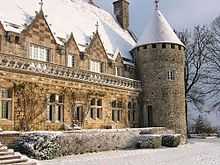Château de Hattonchâtel

The Château de Hattonchâtel is a château in the commune of Vigneulles-lès-Hattonchâtel in the Meuse département of France.
The site was fortified in 860 by Hatto, Bishop of Verdun, whose name it bears, on a rocky promontory overlooking the Seine valley. The settlement became the chief stronghold of the bishops and also the location of their mint until 1546. In 1636 the retreating Swedes besieged and burnt most of the town.
The original medieval castle was destroyed during World War I in 1918. The site was entirely reconstructed between 1923 and 1928 by Henri Jacquelin, a Norman architect originally from Evreux, in the Neo-Renaissance style. He produced the ultimate "troubadour" château of Lorraine, a pastiche which used some remains from the 11th century building. The work was financed by the American benefactor Belle Skinner.[1]
The Château de Hattonchâtel has been listed as a monument historique by the French Ministry of Culture since 1986 and is privately owned...[1]

The château is presently run as a hotel, wedding and conference centre.
The village of Hattonchâtel was an autonomuos commune until 1973, when with several atoher villages it was incorporated in the Vigneulles-lès-Hattonchâtel municipality.
See also
References
External links
| Wikimedia Commons has media related to Château d'Hattonchâtel. |
- Château de Hattonchâtel: official hotelier's website
- French Ministry of Culture listing for Château de Hattonchâtel (French)
Coordinates: 48°59′33″N 5°42′21″E / 48.99250°N 5.70583°E